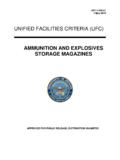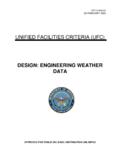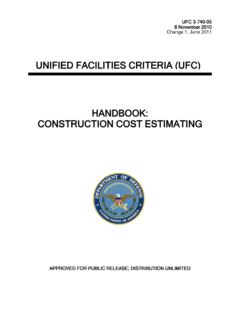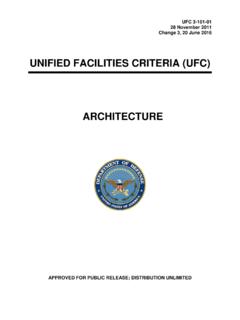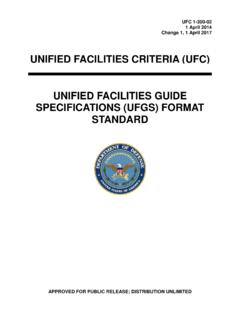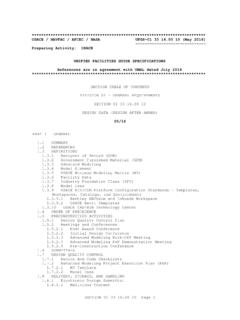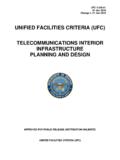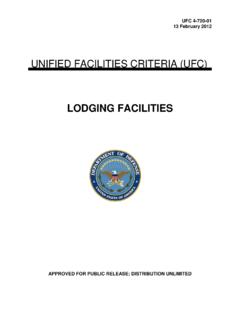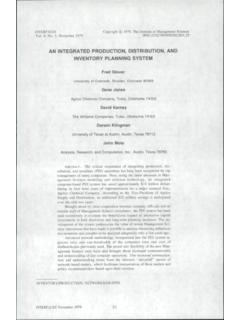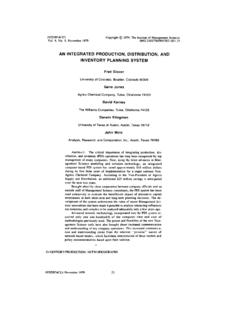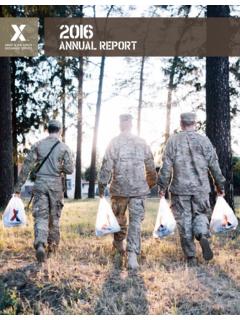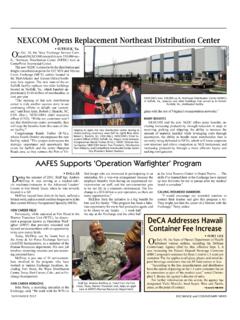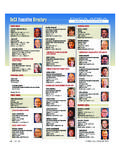Transcription of CHAPTER 1 INTRODUCTION - WBDG
1 UFC 2-000-05N. CHAPTER 1. INTRODUCTION . Table of Contents 1-1 PURPOSE OF PUBLICATION .. 2. 1-2 BFR PROCESS .. 2. 1-3 BFRs FOR USMC INSTALLATIONS .. 2. 1-4 ORGANIZATION OF UFC 2-000-05N .. 3. CATEGORY CODE NUMBERS .. 3. PAGE NUMBERING AND APPENDICES .. 3. WEB ACCESS OF PUBLICATION AND COMMENTS .. 4. 1-5 REQUIREMENTS IN THE REGIONAL CONTEXT .. 4. REGIONAL PLANNING .. 4. METHODS FOR CALCULATING REGIONAL REQUIREMENTS .. 5. Table 1-1. Regional Travel Times (CCN 740, 750 and 760 Series).. 6. 1-6 COMPONENTS OF BFR DEVELOPMENT .. 7. PROJECTED MISSION, FUNCTIONS, AND TASKS.
2 7. BASE LOADING .. 7. Table 1-2. Potential Aircraft Loading Sources .. 8. Table 1-3. Potential Ship Loading Sources .. 9. Table 1-4. Potential Personnel Loading Sources .. 9. Table 1-5. Dependent Data .. 12. Table 1-6. Potential Equipment Assigned Loading Sources .. 12. CRITERIA .. 13. 1-7 ADDITIONAL PLANNING GUIDANCE .. 14. ADJUST FOR OPERATIONAL CONDITIONS .. 15. UNDERSTAND HOST / TENANT RELATIONSHIPS .. 15. USE SOUND PROFESSIONAL JUDGMENT .. 15. REFERENCE DOCUMENTS .. 16. EXAMPLE OF WORKSHEET .. 17. 1. UFC 2-000-05N. 1-1 PURPOSE OF PUBLICATION. This Facility Criteria publication, UFC 2-000-05N was formerly designated as NAVFAC P-80 under the same title.
3 It provides the space planning factors, criteria and techniques for use in developing Basic Facility Requirement (BFR) calculations and assessments. Establishing the BFR provides the space demand or support requirement for shore-based facilities, by category code, necessary to perform the peacetime missions of Navy shore activities. A BFR justification is the calculation of an installation, command, or region's facilities allowances based upon established planning criteria. The BFR calculation can be modified (with justification) to accommodate site-specific or unit-specific loading requirements, such as mission, personnel, functions and equipment.
4 BFRs encompass entire functional categories of use, such as administrative offices, general warehouses or public works shops, for both host and tenant commands. For each of the activity's functional categories, if the sum of all current assets assigned to that category code is greater than the calculated requirement in the BFR, there is a surplus of space; if it is less, there is a deficiency. BFRs should be updated periodically and must be updated when there is a change in loading or a change in mission. The purpose of this publication is to present the specific criteria and algorithms used to prepare BFRs for different categories of functional uses.
5 1-2 BFR PROCESS. Information about the process of preparing BFRs can be found in the Naval Facilities Engineering Command (NAVFAC) Business Management System (BMS), which provides a systematic method for the management of various business processes and common practices that produce and/or support production of NAVFAC products and services. The BMS provides best business processes documentation and links to applicable, appropriate and up-to-date policies, guidance, forms and information. The BMS process guide for production of BFRs is located on the NAVFAC portal website at the following secure address: 25_7_1_1_basic_facility_requirements/tab -b25-7-1-1-home 1-3 BFRs FOR USMC INSTALLATIONS.
6 When preparing BFRs for United States Marine Corps (USMC) installations or for any USMC facilities on Navy installations, the facility planner shall refer to Marine Corps 2. UFC 2-000-05N. Order (MCO) (with current changes): Real Property Facilities Manual, Volume II, Facilities Planning and Programming . 1-4 ORGANIZATION OF UFC 2-000-05N. CATEGORY CODE NUMBERS. CHAPTER 2 of this UFC 2-000-05N publication is organized by Category Code Numbers (CCNs), the sequence of which generally corresponds to functional areas and activities. A complete database of the Department of the Navy CCNs, with supporting facility type and economic factor datafields is available on the Internet Navy Facility Assets Data Store (iNFADS) which can be accessed through the secure NAVFAC web portal at: A list of Department of the Navy CCNs is also available with a short descriptive title and associated units of measurement at the following web address: The system of Category Code Numbers is grouped using the following series.
7 100 Series Operational and Training Facilities 200 Series Maintenance and Production Facilities 300 Series Research, Development, Acquisition, Test and Evaluation Facilities 400 Series Supply Facilities 500 Series Medical Facilities 600 Series Administrative Facilities 700 Series Housing and Community Facilities 800 Series Utilities and Ground Improvements Facilities 900 Series Real Estate Facilities PAGE NUMBERING AND APPENDICES. The page numbering system in CHAPTER 2 of this publication corresponds to the first three digits of the category group. The appendices to this document are: Appendix A contains a current listing of Dept.
8 Of the Navy CCN's, reflecting data recently downloaded from the NAVFAC iNFADS database. Appendix B is a list of applicable units of measurement and their abbreviations. Appendix C is the NAVFAC : Runway Capacity Handbook - Fixed Wing. Appendix D is the NAVFAC : Naval Mobile Construction Battalion Facilities. Appendix E is the NAVFAC : Airfield Safety Clearances. Appendix F is the Austere Facilities Planning Criteria. 3. UFC 2-000-05N. WEB ACCESS OF PUBLICATION AND COMMENTS. This publication and its appendices can be found at The criteria elements included in this publication are dynamic.
9 As such, they are subject to continuous comment, review and update. Users of this criteria are encouraged to submit comments and recommendations regarding the content, application and/or format of the publication for consideration and review. Comments are submitted through the Criteria Change Request system on the WBDG website, at the following web address: . Include your contact information, as well as sufficient explanation for evaluation of the recommended changes to the criteria. 1-5 REQUIREMENTS IN THE REGIONAL CONTEXT. REGIONAL PLANNING. Navy leadership is departing from the traditional paradigm, which managed shore infrastructure at the level of individual shore activities.
10 Under Regionalization and the Installation Claimant Consolidation programs, the Navy is shifting toward managing and planning facilities in a larger, regional context (for example, a collection of military installations in geographic proximity to one another). This comprehensive regional approach to planning broadens the field of opportunities beyond those available on an individual activity to include the geographic and functional context of the region. Regional planning looks to reduce redundant facilities within a geographic region and seeks alternative means of satisfying requirements for infrastructure, such as leasing, outsourcing and privatization.
